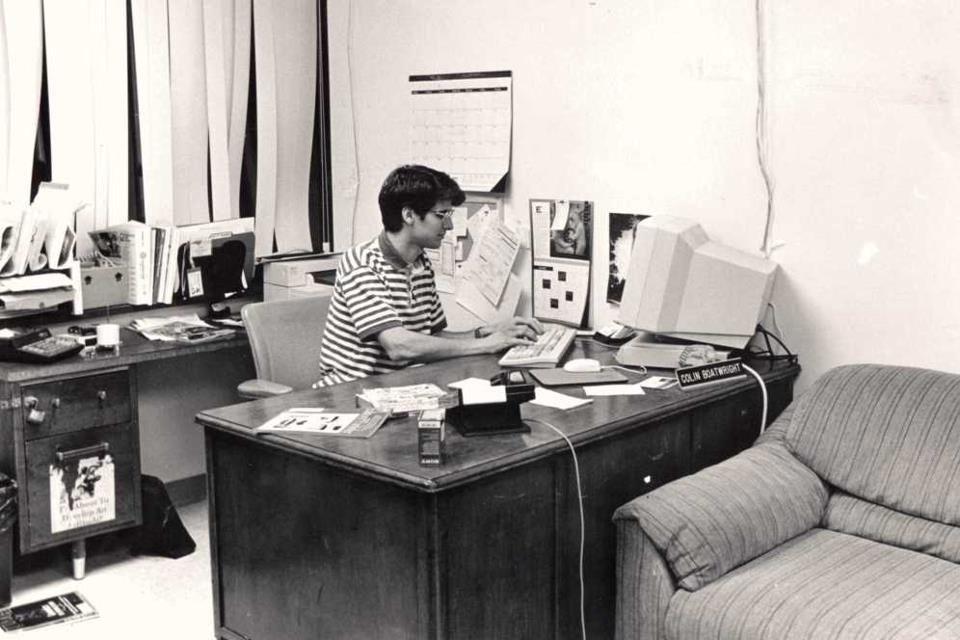For most of its history, Technician was primarily a print newspaper, but in recent years, as new technology like desktop publishing and the internet became accessible, the publication has embraced a truly “web-first” approach.
Colin Boatwright, the editor-in-chief of Technician from 1994-95, led the charge to publish Technician online for the first time in 1994.
“I did a lot of desktop publishing part-time work; that’s kind of how I put myself through college,” Boatwright said. “So I thought, ‘Why don’t I do this here?’”
Boatwright said he spent the year before he became editor-in-chief as a production manager and an editorial page editor, putting together physical copies of the newspaper. He said expanding to online just made sense.
“It just seemed like the thing to do,” Boatwright said. “Moving it online was — I’m not going to say trivial — but once you fully digitize your production process, moving it over to a website was pretty easy.”
Campus partners, including the chancellor, were supportive of the move, Boatwright said. Technician’s staff was given space on some of NC State’s servers, and for the most part Boatwright and Hunter Morris, design editor from 1993-96, were left to digitally publish on their own.
“[Morris] was an engineer,” Boatwright said. “He had enough [knowledge], like me, to figure out all the coding and wiring it together. Probably it was a perfect storm of him being there and me being there, and we were able to bounce [ideas] off [each other] a lot. We knew we needed to make it relatively automated; we were already there late enough at night as it was.”
Boatwright said all the pieces were there from previous years to fully move toward modern publishing, and he didn’t feel that he was making history so much as moving things along to the right place.
“There was certainly the foundation [that] had been built over the past three or four editors before me,” Boatwright said. “I just took it across the finish line to get it to the desktop publishing suite and online. Once you’re digital, you can do so much more with it.”
The transition to online publication has not been without its pitfalls, according to Patrick Neal, director of Student Media. Neal said not only has Technician had to adjust to publishing online, but the entire landscape of the newspaper industry has seen a massive shift.
“It is not any exaggeration to say that the traditional business model for newspapers has collapsed in the last 10 years,” Neal said. “That’s not just us; that’s other college newspapers, that’s community newspapers, that’s national newspapers. No newspaper, to my knowledge, has gone unscathed. That has driven part of our actions over the past few years.”
Technician’s non-fee revenue from advertising sales has plummeted from approximately $500,000 in 2003-2004 to under $100,000 in 2017-18, according to that year’s Student Media annual report. To respond to the drop in revenue and better meet reader expectations, the Student Media Board of Directors drastically reduced the frequency of print editions. Starting in 2018, Technician began publishing a physical paper just once a week, saving tremendous amounts in printing costs and furthering a web-first attitude.
While publishing online was something Technician was familiar with for over a decade, the publication only began to dive into social media in the last few years, according to Sarah Catherine Smith, digital content editor for the 2015-16 academic year. Smith said that while social media platforms were used before her time as editor, she brought a stronger focus to them during her tenure.
“When I took it over, I don’t think anyone really cared much about it,” Smith said. “It wasn’t a position, and it wasn’t something we really did, but at the time I was working at a creative agency, and I was like, ‘This is very important, and we should put emphasis on it, because most of our reader base is online.’”
Sharing news through social media allows Technician to reach an incredible number of people, Smith said, recalling major events.
“I just remember when the Our Three Winners incident happened, when the shooting happened, a bunch of our content went nationally viral,” Smith said. “That was the first time I had seen that. I remember some of our tweets, and some of our photos and galleries. I know our tweets were getting 300,000 impressions.”
Though digital publishing continues to grow, Smith said print publications shouldn’t be put aside entirely.
“I think online content, it was a big deal, and it still is a big deal,” Smith said. “I think print has a time and a place, and it has a specific audience. I don’t think that will ever go away.”
Breaking news online has become critical, Neal said. Publishing breaking news online as opposed to in print is almost always the priority.
“They’re adding content daily,” Neal said. “That has been the silver lining, and it is an enormous one, of cutting back on the print publication schedule.”
While the reduction in printing is the result of a collapse of the news publishing industry, the decisions to reduce printing have had the side benefit of massively decreasing waste, according to Neal.
“It has made us a lot greener,” Neal said. “When we were printing five days a week, 10,000 copies a day on a broadsheet format, that is a lot of paper, and a lot of paper was, frankly, not getting picked up. We were throwing away most of those because they were out on the stands for 24 hours, in most cases, and then it was time to switch it out with the new newspaper. Today, we print 4,000 copies once a week at a reduced size.”








